Chapter 3: The Earth: Differentiation & Plate
Tectonics
While the Proto-Earth was probably a clump of chaotically mixed cosmic dust and gases,
this is not what we know it to be today. At our current state of knowledge we view the
Earth as consisting of a number of superimposed layers/shells that differ in composition
and properties.
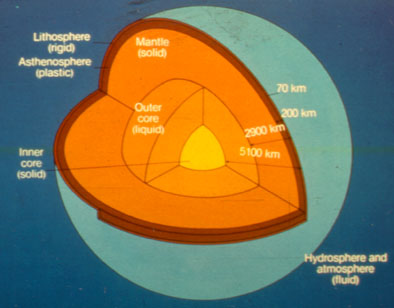 |
The major subdivisions of the Earth are:
(from inside to outside)1) the inner core (mostly solid iron)
2) the outer core (mostly liquid iron)
3) the Mantle (solid Fe/Mg silicates)
4) the Crust (solid K/Na silicates)
5) an outer film of water and gases
(hydrosphere & atmosphere) |
How do we know this? Has anybody ever been down there? Have we drilled
holes into the center of the Earth and retrieved samples? The answer is no on both
counts. It's too hot and the pressures are too high. But we are not stuck in
absolute ignorance. Just as when we pondered the universe, it pays to make
assumptions and to see if they are supported by the facts. Newtonian mechanics
allows us to determine the overall mass of the Earth, and because we know the diameter
(12,756km) and thus the volume of the Earth, we can calculate its average density as 5.515
g/cm3. If the Earth were more or less homogeneous, rocks found at
the Earth surface should be in density around 5 to 6 g/cm3. When we
measure them, however, we find that their density is on the order of 2.6 and 2.7
g/cm3. Obviously, if the density is below average at the surface, the
density must be above average on the inside. Tinkering back and forth with the
densities of many minerals and the relative abundance of elements in the solar system it
is unlikely that any silicate mineral at depth can account for the necessary high inner
density. The only materials of suitable density are heavy metals, such as iron,
nickel, cobalt, copper, etc. Of the heavy metals, iron is
cosmically most abundant, and
thus a perfect candidate. In the past there have been the
suggestion that certain structures in iron-nickel meteorites are indicative of
an origin in the interior of a planet, and suggested that iron cores should be
common in the interior of planets. These structures (Widmanstaetten Structure)
in a mineral intergrowth named (octahedrite)
supposedly indicated pressures that only were to be found in the interior
of planets. We know now that these structures are more a reflection of cooling
history, and probably could not have formed in planetary bodies that were larger
than about 850 km (cooling too slow).
The idea that the asteroid belt
of the solar system may contain the remnants of a former planet is based on the
assumption that octahedrite forms in the interior of earth size planets. This
line of reasoning thus reduces the likelyhood that the Asteroid Belt consists of
the fragments of a former planet.
Other evidence about the layered nature of the Earth comes from the observation and
measurement of sound waves that travel through the Earth. These waves (seismic
waves) are created naturally by earthquakes, and artificially by huge explosions (e.g.
nuclear tests). As they travel trough the Earth they reveal its internal structure.
This branch of earth sciences is also known as
seismology.
The next page illustrates how
seismic helps to
understand the Earth's structure. Basically, our knowledge of the position
of the various boundaries (inner/outer core, core/mantle, crust/mantle) seen in the above
figure, as well the physical properties of the various layers (density, velocity of sound)
are largely due to seismic studies.
Obviously, something happened to change our Proto-Earth from the "dirty
snowball" nature of a comet to the solid planet we know today. We know already
that because the Earth was comparatively close to the sun, it lost most of its volatiles
as the Sun started to heat up. Thus, it is a very dense planet (5.515 g/cm3)
when compared to a gas giant like Jupiter (1.33 g/cm3). Now we have to
ask how the materials that made up the early earth could have "unmixed" to form
the currently observed structure.
This kind of "unmixing" or segregation is often described as differentiation
by geologists, and
differentiation
caused the heavy metals (iron, nickel and related elements) to be concentrated in the core
of the earth, whereas the light elements (oxygen, silicon, aluminum, potassium, sodium,
calcium etc.) were enriched in an outer layer of the earth that is now termed the upper
mantle and the crust. Gravity, however, is not the only process that drives
differentiation. Chemical affinities can also play an important role. Uranium
and Thorium, for example, are very heavy elements, and contrary to expectation they are
concentrated in the crust (primarily) and mantle. The reason for this aberration is the
circumstance that ion size and chemical affinities of U and Th prevent them from being
incorporated in the dense, tight crystal structures that are stable at the high pressures
encountered in the earth's core. Because they can fit much more easily into the more open
crystalline structures of silicate and oxide minerals, they are enriched in crust and
mantle.
After the establishment of the internal structure depicted above, the earth reached
approximate thermal equilibrium (heat generation balanced by heatflow through the earth's
surface). Heat can be transported and transmitted in a variety of ways, such
as conduction (through a copper rod), radiation (feeling the heat of a fire), and
convection (hot water rising in a pot).
Convection is the most
efficient of these, and is found to play a role in many geologic processes. It is
also the main process by which heat is moved to from the interior to the exterior regions
of the Earth.
Convection
implies fluid behavior where hot material rises due to its lower density, and cold
material sinks due to its higher density.
Just as many other things that go on in the Earth's interior, convection in its
interior can not be observed directly. Fortunately, however, the conveyor belt
motion that accompanies convection is evident in the way the Earth's crust moves.
The theory that describes these motions is known as
Plate Tectonics, and
is the theory that brings together observations from many branches of earth science into a
coherent whole.
Plate Tectonics
In a nutshell, the
basics of
plate tectonics are these:
1) the Earth's crust consists of a number of rigid plates
2) these plates move and interact with each other
3) the driving force behind plate tectonics is convection in the mantle
4) in areas of mantle upwelling (rising hot mantle material) the crust is stretched apart
and new crust is generated
5) in areas of mantle downwelling (sinking cold material) crust is "swallowed"
up (subducted)
6) there are two types of crust: oceanic crust (thin, basaltic), and continental crust
(thick, granitic)
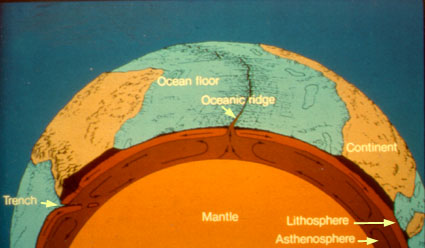 |
This picture summarizes the essential aspects of plate
tectonics. In areas of mantle upwelling, hot material rises, magma (molten
rock) is generated, and fills in the cracks caused by the spreading apart of the crust.
These sites where new ocean crust is generated are also known as
(mid)
oceanic ridges (raised because of the material that rises beneath them).
Because the volume of the Earth has to remain constant, for every square mile of crust
that is generated at oceanic ridges, another square mile has to disappear somewhere else
on Earth. This disappearance act takes place at so called
deep sea trenches.
There the ocean crust is recycled back into the mantle (subduction).
Because plates press against each other in these places, the crust tends to get
buckled up and thickened, and we see the formation of
mountain ranges and lots of
earthquakes.
Mid-oceanic ridges and subduction zones are also sites of
intense volcanism.
At mid-oceanic ridges it is due to basalt rising from the upper mantle, at
subduction zones it is due to melts (andesite) forming from the descending plate. |
The basic data for this theory come from the recognition that the continents have moved
around on the Earth through time, an idea that was most prominently advocated by
Alfred Wegener in the first few decades of
this century. It was called
Continental Drift at the time.
Wegener also was one of the first to suggest that convection within the Earth might
be a driving force behind continental drift. At the time, however, we lacked the
basic knowledge of some of the critical features of the ocean floor, and the theory was
dismissed by most of Wegener's contemporaries.
Following W.W.II, improved instrumentation and a growing knowledge of the ocean floor
produced new insights into crustal dynamics.
Sonar technology provided scientists
with unprecedented detail about seafloor topography, and revealed the extent of
mid-oceanic ridges and deep sea trenches. Together with geophysical data (crustal
heat flow, earthquakes, paleomagnetism), these observations were critical for the
formulation of the plate
tectonics theory.
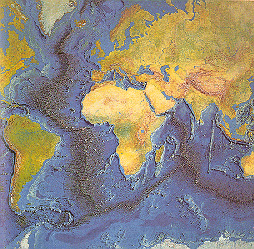 |
The topography of the Atlantic and Indian Ocean. Shows mid oceanic ridges as
raised elements within the ocean basins. Along the center of these ridges basaltic
magma rises up from the mantle, and fills cracks that are caused by convective stretching
of the ocean crust. New ocean crust is constantly generated along the ridges (at a
rate of a few cm's to inches per year), and causes for example the Atlantic to widen over
time. We can also see that the Mid-Atlantic Ridge is symmetrical between Africa and
South America. Thus, equal amount of seafloor were created to the left and right of
the ridge, and a long time back (in the Jurassic) Africa and South America were actually
joined together. |
By studying ancient rocks, geologists can
trace the plate motions back in time and
develop a picture of how our Earth developed through Earth history. The animation
below shows one attempt of such a reconstruction (by Dr. Scotese of the UTA Geology
Department). The counter tells millions of years before present, and the red arrow
indicates the period within Earth history. (If necessary, hit reload to activate
animation).
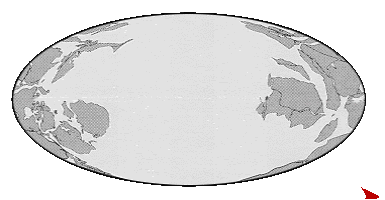 |
 |
Once thermal equilibrium of the early earth had been reached (it radiated as much heat
to space as was newly generated inside) and a solid crust had formed (may be by about 4
billion years ago), mantle convection was the mechanism by which the hot interior was
cooled. This convection drove (and drives) the plate tectonics engine, and is
responsible for much of the crustal dynamics since then. In a way, living on the
surface of the Earth's crust, we are sitting on the outside of a giant heat exchanger.
As a whole, this portion of the Earth System is called the
Tectonic System.
While the early Earth was reorganized into shells of differing composition, something
else happened that is of prime importance to life on the planet.
Gases that were
mixed in with the original planetary matter were released during differentiation and early
(probably very vigorous) volcanism. These gases formed the Earth's earliest
atmosphere,
and once surface temperatures had dropped sufficiently, water condensed and formed oceans,
lakes and rivers (hydrosphere).
The reason why water and atmospheric gases are still present after billions of
years of geologic history is because (1) the gravitational attraction of the
Earth, and (2) the temperatures in the atmosphere. For gas molecules to
escape from Earth they have to reach escape velocity, and that velocity is a
function of temperature and the weight of the gas molecule (heavier molecules
move slower at a given temperature) . Only hydrogen has low enough molecular
weight to reach escape velocity under atmospheric temperature conditions, and
because of oxygen in the Earth atmosphere free hydrogen is not "allowed" (it
combines with oxygen to form water, a heavier and thus slower moving molecule).
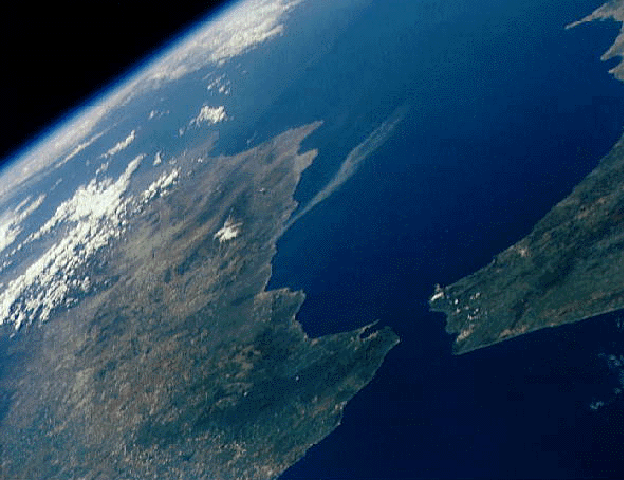 |
Most of the water that makes up the
hydrosphere probably originated
during the early outgassing phase
of the Earth. Most of the water in the hydrosphere (96%) is contained in the
oceans which cover
approximately 70% of the Earth's surface and are on average 3800 m deep. The
remainder of the water
is found in ice caps & glaciers (3%), rivers, lakes, and groundwater (1%).
Thus, only a very
small fraction of the overall water supply is suitable and available for human use. |
After water vapor had condensed to form the oceans, lakes and rivers, the remaining
gases formed the Earth's atmosphere.
 |
Relative to the size of the Earth, the
atmosphere is a thin layer that covers the surface of the planet. Although scientists consider it to be about
480 km
(300 miles) thick, most of it is so thin that humans can not survive.
Most human
activity occurs in the lowermost 3-4 miles that contain the bulk of the gases in the
atmosphere. Going up much higher requires special equipment (oxygen masks,
pressurized cabins). The point where the atmosphere is at 10% of the surface
pressure is the top of the lowermost layer of the atmosphere, the so called troposphere.
The troposphere is that part of the atmosphere where most of our weather is
happening (clouds, circulation systems, etc.). Above the troposphere come
stratosphere (the ozone layer), and ionosphere (aurora borealis, meteors, short-wave radio
reflectors). The modern atmosphere is composed mainly of nitrogen (75%),
oxygen (23%), argon (1.3%), carbon dioxide (0.5%), and traces of other gases, such as
hydrogen, helium, neon, crypton, xenon, and compounds of those gases (ozone, nitrous
oxide, ammonia). The early Earth atmosphere was very different from what we know it
to be today, an issue that we will explore further as this lecture proceeds. |
The estimated age of the solar system, including the Earth, is about 4.6 billion years.
This figure is based on a comparison of radiometric age determinations from Earth
rocks, meteorites (the leftover debris from the solar system’s formation), and Moon
rocks (compared to the Earth, the Moon is a geologically dead world where new rock has not
been created or destroyed for billions of years). Because the oldest crustal rocks
and minerals date back to as much as 4.3-4.4 billion years, a solid crust and plate
tectonics may have been present just 200-300 million years after the initial accretion of the
Earth. The preserved geologic record starts at about that time, and it appears that
since then the recycling of energy and matter at the Earth's surface and in its interior
have operated pretty much in the same way as they do today.
The Earth is an interacting system of matter and energy, that as part of its
functioning produces phenomena like volcanoes, glaciers, mountain ranges, oceans, and
continents. The energy that keeps this system going is on one hand the internal heat
(from radioactive decay) that drives plate tectonics, and on the other hand solar energy
that maintains ocean and atmosphere circulation and helps to drive erosion.
Chapter 4
...........
I'd like to get away from earth awhile
And then come back to it and begin over.
May no fate willfully misunderstand me
And half grant what I wish and snatch me away
Not to return. Earth's the right place for love:
...........
From: "Birches" by Robert Frost, 1915






